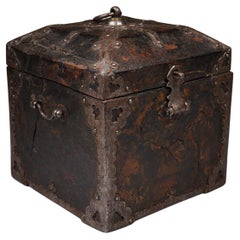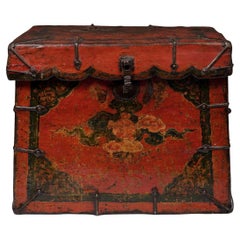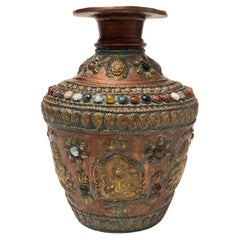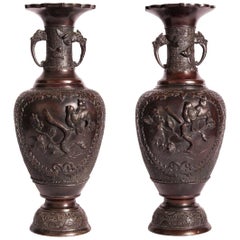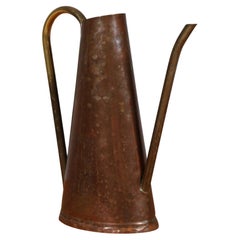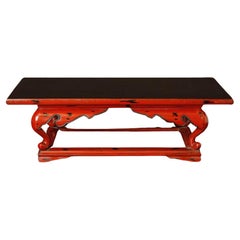Tibetan Urns
to
4
3
1
4
2
2
1
1
3
1
570
1,678
808
312
274
Height
to
Width
to
4
4
4
Place of Origin: Tibetan
17th/18th Century Wood, Leather and Metal Trunk, Tibet
Located in Point Richmond, CA
Trunk
Tibet
17th/18th century
Wood, leather, metal
H: 8 in x W: 8.5 in x D 8.5 in :: 20.3 x 21.6 x 21.6 cm
A slightly domed top hinged trunk with brass handles, closures and sculpte...
Category
17th Century Tribal Antique Tibetan Urns
Materials
Metal
Ca. 17th Century Wood, Mineral Pigment and Iron Metalwork Trunk, Tibet
Located in Point Richmond, CA
Trunk
Tibet ...
Category
17th Century Tribal Antique Tibetan Urns
Materials
Iron
Antique Tibetan Copper Brass Bronze, Gem-inlaid Water Vessel
Located in Louisville, KY
Copper vessels such as this have been made for literally centuries by Tibetan monks and other cultural sectors. The craftsmanship is wonderfully rustic with hammered copper, brass an...
Category
19th Century Tibetan Antique Tibetan Urns
Materials
Multi-gemstone, Brass, Bronze, Copper
Pair of 18th Century Bronze Tibetan Vases
Located in London, GB
This pair of antique 18th century vases are cast entirely in bronze, and have ovoid-form bodies which are decorated with reliefs of birds, flowers and trees. The bodies are surmounte...
Category
18th Century Antique Tibetan Urns
Materials
Bronze
$6,157 / set
Related Items
Carl Auböck style Watering Can in Copper and Brass
By Werkstätte Carl Auböck
Located in Esbjerg, DK
Rare watering can in style of Carl Auböck.
Category
1950s Mid-Century Modern Vintage Tibetan Urns
Materials
Brass, Copper
Japanese Negoro Style Lacquered Worship Stand, 17th-18th Century
Located in Fukuoka, JP
"Discover a piece of Japanese religious heritage with this exceptional Negoro lacquered stand. Crafted in the 17th to 18th century, this worship article stand is a prime example of e...
Category
Late 17th Century Edo Antique Tibetan Urns
Materials
Wood, Lacquer
$1,780
H 6.11 in W 10.63 in D 20.08 in
Japanese Samurai Abumi Stirrups Lacquer Edo, 18th Century
Located in Dallas, TX
Japanese Samurai Abumi Stirrups lacquer Edo late 18th century, early 19th century.
Measures: 12 inch length, 10 inch height, 5.5 inch width.
AVANTIQUES is dedicated to providing an...
Category
Late 18th Century Edo Antique Tibetan Urns
Materials
Iron
17th Century Japanese Export Lacquer Cabinet with Depiction the Dutch Tradepost
Located in Amsterdam, NL
A highly important Japanese export lacquer cabinet with depiction of the Dutch East India Company tradepost Deshima and the annual Dutch delegation on its way to the Shogun in Edo
Edo period, circa 1660-1680
H. 88 x W. 100.5 x D. 54 cm
This cabinet includes a later European japanned stand, but also a modern powder-coated steel frame.
The latter can be designed and added to your specific needs.
The sides and front of the rectangular two-door cabinet are embellished in gold and silver hiramaki-e and takamaki-e on a black roiro lacquer ground with a continuous design. The two doors depict a long procession of numerous figures travelling on foot and horseback along buildings and a pagoda into a mountainous landscape. This is the annual court journey, Hofreis, of the Dutch from Nagasaki to the Shogun’s court in Edo. Three horseback riders are dressed as Dutch merchants and a fourth figure, probably het Opperhoofd, is seen inside a palanquin, norimon. Just about to cross the bridge, two men are carrying a cabinet like the present one.
Many Japanese figures on either side of the procession are engaged in various activities; some play musical instruments on board of small boats, others are fishing; figures inside buildings are depicted playing go, and farmers are tending to their rice paddocks. The upper part of the right door shows a large mansion, probably the local daimyo’s castle, with men kneeling before a man in the central courtyard.
The court journey fits in with the foreign policy of the shogunate which accorded a role to the VOC alongside China, Korea, and the Ryukyu Islands who also had to pay tribute. However, the VOC employees were traders, having low status in Japan’s social hierarchy, and they were received with less deference than were the state embassies from Korea and the Ryukyu Islands. Nevertheless, the contacts with the Dutch were a welcome source of information to the Shogun about Europe and European science and technology.
The left side of the cabinet depicts, in mirror image, a rare view of the artificial fan-shaped Deshima Island, the trading post for the Dutch in Japan. The island, where the Dutch flag flies, is surrounded by small Japanese boats and an anchored three-masted fluyt (cargo ship), flying Dutch flags, with on the stern the VOC monogram. On the bottom right a busy street of Nagasaki is shown, bordered by shops and leading up to the stone bridge. On the island the trees are beautifully painted, two cows can be seen, and the flagpole, all in very fine detail. Dutchmen and enslaved Malay are visible outside the buildings and two Japanese figures, probably guards, sit in a small hut in the centre.
A maximum of fifteen to twenty Dutchmen lived on the island at any time and soldiers or women were not allowed. Restrictions on Deshima were tight, and the merchants were only allowed to leave the island by special permission. The Opperhoofd had to be replaced every year, and each new Opperhoofd had to make a court journey to pay tribute, present gifts, and to obtain permission to Margaret Barclay eep on trading. In the distance, many birds fly above the hills and a four-story pagoda can be seen. The right side of the cabinet is painted with other horse riders and their retinue journeying through mountains.
The pair of doors to the front open to reveal ten rectangular drawers. The drawers are decorated with scenes of birds in flight and landscapes with trees and plants. The reverse of the left door with two thatched buildings, one with a ladder, underneath a camelia tree with large blooms; the right door with a three-story pagoda nestled among trees and both doors with a flying phoenix, ho-oo bird. The cabinet, with elaborately engraved gilt copper mounts, hinges, lock plates and brass handles, is raised on an 18th-century English japanned wood stand.
A pair of large cabinets...
Category
17th Century Edo Antique Tibetan Urns
Materials
Copper, Gold
$1,484,721
H 34.65 in W 39.57 in D 21.26 in
Pair of Chinese 18th Century Flambe Glazed Trunk Form Vases
Located in Austin, TX
A pair of vases molded as naturalistic plum tree trunks, with applied decorations of flowering plum branches. All are covered by a rich flambe glaze of predominantly fuchsia, with st...
Category
Late 18th Century Qing Antique Tibetan Urns
Materials
Stoneware
Pair of bronze and marble vases. 19th century.
Located in Madrid, ES
Pair of vases. Bronze, marble. XIX century.
Pair of vases made of carved light marble with a stepped and circular base of the same material that also have decorative details in gild...
Category
19th Century Neoclassical Revival Antique Tibetan Urns
Materials
Marble, Bronze
Rare Charming 17th Century Japanese Lacquer Cabinet with Gilt-Bronze Mounts
Located in Amsterdam, NL
A fine Japanese pictoral style lacquer cabinet with gilt-metal mounts
Kyoto, Edo period, 1670-1690
Decorated in Japanese relief lacquer work, black lacquer ground decorated...
Category
Late 17th Century Antique Tibetan Urns
Materials
Bronze
$44,541 Sale Price
25% Off
H 23.82 in W 24.02 in D 18.31 in
Antique Spanish Colonial Majolica Pottery Water Vessel Pitcher
Located in New York, NY
Spanish Colonial majolica pottery water pitcher / vessel from the highlands of Guatemala. This piece has such character, with majolica glaze and traditional decorative design applied...
Category
19th Century Spanish Colonial Antique Tibetan Urns
Materials
Pottery
Round Copper Watering Can
Located in Los Angeles, CA
A lovely vintage watering can, fully functional and ideal for the inside plants, a greenhouse area or your smaller garden plants... pretty enough ...
Category
20th Century Mid-Century Modern Tibetan Urns
Materials
Copper
Antique 18th Century Export Chinese Lacquer Gaming Box
Located in Brea, CA
Antique 18th century export Chinese lacquer gaming box with hand painted scenes gilt export black lacquer, there are 7 gaming boxes and 12 trays, size: ...
Category
Late 18th Century Qing Antique Tibetan Urns
Materials
Lacquer
Japanese Lacquer Incense Box, Kogo, Momoyama or Edo Period, 16th/17th Century
Located in Austin, TX
A wonderful Japanese lacquer incense box, kogo, with a design of plovers in flight, late Momoyama or early Edo Period, circa 1600, Japan.
The small box, called a kogo, was used to s...
Category
Early 17th Century Edo Antique Tibetan Urns
Materials
Gold, Pewter
$6,000
H 2.75 in W 3.75 in D 3.75 in
Rare 18th Century Red Lacquer Presentation Box
Located in Richmond, London
An extremely rare and unusual 18th century red lacquer presentation box, intricately gilt-decorated with immortals, auspicious symbols and poetry.
Canton, Qing dynasty, circa 1760.
...
Category
Mid-18th Century Antique Tibetan Urns
Materials
Lacquer
Recently Viewed
View AllMore Ways To Browse
Sevres Urns Signed
Wedgwood England Urn
19th Qing Urn
Blue John Urns
Bronze Urn With Lid
Derbyshire Spar
Gold And White Urn Ram Head
Turned Wood Urns
Basalt Urns
Bird And Flower Urn
Black Basalt Urn
Capodimonte Urn
Carl Thieme Potschappel
Chinese Incense Urn
Chinese Temple Urn
Cobalt Bronze Urns
Jade Urn
Large Majolica Urn
